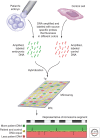Genetic considerations in recurrent pregnancy loss
- PMID: 25659378
- PMCID: PMC4355257
- DOI: 10.1101/cshperspect.a023119
Genetic considerations in recurrent pregnancy loss
Abstract
Human reproduction is remarkably inefficient; nearly 70% of human conceptions do not survive to live birth. Spontaneous fetal aneuploidy is the most common cause for spontaneous loss, particularly in the first trimester of pregnancy. Although losses owing to de novo fetal aneuploidy occur at similar frequencies among women with sporadic and recurrent losses, some couples with recurrent pregnancy loss have additional associated genetic factors and some have nongenetic etiologies. Genetic testing of the products of conception from couples experiencing two or more losses may aid in defining the underlying etiology and in counseling patients about prognosis in a subsequent pregnancy. Parental karyotyping of couples who have experienced recurrent pregnancy loss (RPL) will detect some couples with an increased likelihood of recurrent fetal aneuploidy; this may direct interventions. The utility of preimplantation genetic analysis in couples with RPL is unproven, but new approaches to this testing show great promise.
Copyright © 2015 Cold Spring Harbor Laboratory Press; all rights reserved.
Figures



References
-
- Adler A, Lee HL, McCulloh DH, Ampeloquio E, Clarke-Williams M, Wertz BH, Grifo J 2014. Blastocyst culture selects for euploid embryos: Comparison of blastomere and trophectoderm biopsies. Fertil Steril 28: 485–491. - PubMed
-
- Alberman E 1988. The epidemiology of repeated abortion. In Early pregnancy loss: Mechanisms and treatment, (ed. Beard RW and Sharp F), pp. 9–17 Springer-Verlag, New York.
-
- Aldrich CL, Stephenson MD, Karrison T, Odem RR, Branch DW, Scott JR, Schreiber JR, Ober C 2001. HLA-G genotypes and pregnancy outcome in couples with unexplained recurrent miscarriage. Mol Hum Reprod 7: 1167–1172. - PubMed
-
- Angell RR 1994. Aneuploidy in older women. Higher rates of aneuploidy in oocytes from older women. Hum Reprod 9: 1199–1200. - PubMed
-
- Asadpor U, Totonchi M, Sabbaghian M, Hoseinifar H, Akhound MR, Zari Moradi Sh, Haratian K, Sadighi Gilani MA, Gourabi H, Mohseni Meybodi A 2013. Ubiquitin-specific protease (USP26) gene alterations associated with male infertility and recurrent pregnancy loss (RPL) in Iranian infertile patients. J Assist Reprod Genet 30: 923–931. - PMC - PubMed
Publication types
MeSH terms
LinkOut - more resources
Full Text Sources
Other Literature Sources
Medical
